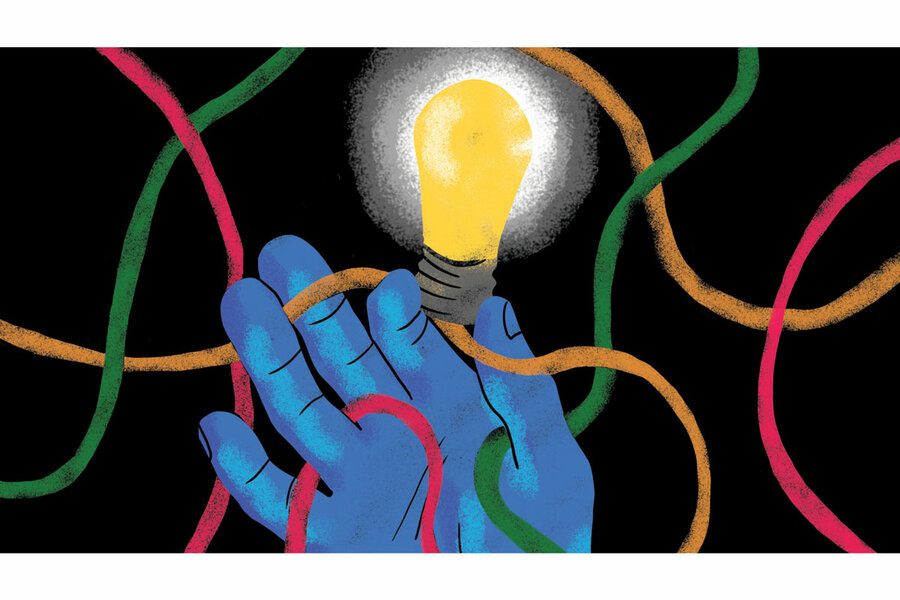Let there be light: Re-sparking my love of learning
Loading...
There I was, a Ph.D. in biology, a veteran professor, an esteemed lecturer, standing like a fresh-faced schoolboy in an adult evening course at a local technical school: Basic Electricity and Wiring.
I felt immediately overwhelmed. So much new terminology, not to mention protocols and safety codes. In an instant, I was a student again in all respects: the anxiety, the self-doubt, the wondering if I had made a mistake.
Why We Wrote This
A story focused onPlacing oneself in uncomfortable situations runs counter to our wiring. But, as our writer learned, in pushing past our self-made boundaries lies discovery, growth, and new horizons.
And then I recalled something President Calvin Coolidge had said about stick-to-itiveness: “Nothing in the world can take the place of persistence.”
Step by step, sometimes achingly, I was learning about voltage, amperage, ground wiring, and various types of electrical fittings. Of course, none of this would have been possible had I not committed myself, sometimes amid tremendous misgivings, to stick with it.
I felt that something bigger than myself was at stake – an affirmation that learning is not something that is wrapped up early in life, from which point we simply sail forth, constantly recycling what we already know. The horizon is broader than that, and the broader the horizon, the more opportunities there are to learn something new.
As a university professor, I have been marinating in theory and conjecture for so long that it recently struck me: I don’t know how to do anything.
By “do,” I mean something material, something done with my hands that produces an actual product.
The trades come to mind. Whenever I call an electrician, or a mason, or a carpenter, I look on in wonder as they fluidly employ their skills. I recently had a new kitchen sink installed by a young man who had dropped out of his college engineering program to take up plumbing. He hummed as he worked at the pipes, with enviable confidence in his abilities. When he was done, the moment of truth: He turned on the water and it flowed forth with nothing resembling a leak. Is this not a minor miracle?
Why We Wrote This
A story focused onPlacing oneself in uncomfortable situations runs counter to our wiring. But, as our writer learned, in pushing past our self-made boundaries lies discovery, growth, and new horizons.
But it is the electrician who, for me, elicits the most wonder. I mean, plumbing is one thing, because you can see water. But electricity is the flow of invisible electrons. I recently had need of an electrician and looked on as she twisted and untwisted and cut and joined masses of wires, which she wove between her fingers like intricately tangled noodles. Again, when she was done, the acid test: a flip of the switch and – voilà! – light.
All of this brought me to a cataclysmic decision: I would go on hiatus from my theories and hypotheses and learn –
actually learn – something about the practical aspects of electricity.
And so, I registered for an adult evening course at a local technical school. The title: Basic Electricity and Wiring.
Perfect.
When we began, I felt immediately overwhelmed. So much new terminology, not to mention protocols and safety codes. In an instant, I was a student again in all respects: the anxiety, the self-doubt, the wondering if I had made a mistake. Was it possible that I didn’t have what it took to understand this field of study?
And then I recalled something President Calvin Coolidge had said about stick-to-itiveness: “Nothing in the world can take the place of persistence. ... Education will not; the world is full of educated derelicts.”
Was this what I was then? An educated derelict? After 30-plus years of university teaching? This thought nagged at me as I worked my way through my basic wiring course. My initial impulse to jump ship gradually gave way to the realization that I was, indeed, acquiring a useful new skill.
Step by step, sometimes achingly, I was learning about voltage, amperage, ground wiring, and various types of electrical fittings. Of course, none of this would have been possible had I not committed myself, sometimes amid tremendous misgivings, to stick with it. (This is as important as it sounds – a third of the class dropped out along the way.)
What loomed ahead was the course’s capstone: Each student would be presented with a switch and a lighting fixture. The task was to install them in a door frame and wire them, but not throw the switch until the instructor was present.
There I was, a Ph.D. in biology, a veteran professor, an esteemed lecturer, standing like a fresh-faced schoolboy before my setup. And so I worked away, wielding my tools, trying to remember where the hot, neutral, and ground wires connected.
When I was done, I raised my hand. The instructor, a master electrician, swaggered over, his expression betraying no hint of what he expected to see. He looked over my job, hummed disconsolately, and glanced at me. “Hit the switch,” he said.
It’s hard to characterize that moment. It would be an exaggeration to say that I felt that the fate of the planet depended on my success. But I did feel that something bigger than myself was at stake – an affirmation that learning is not something that is wrapped up early in life, from which point we simply sail forth, constantly recycling what we already know. The horizon is broader than that, and the broader the horizon, the more opportunities there are to learn something new.
I hit the switch.
There was light.
In more ways than one.







